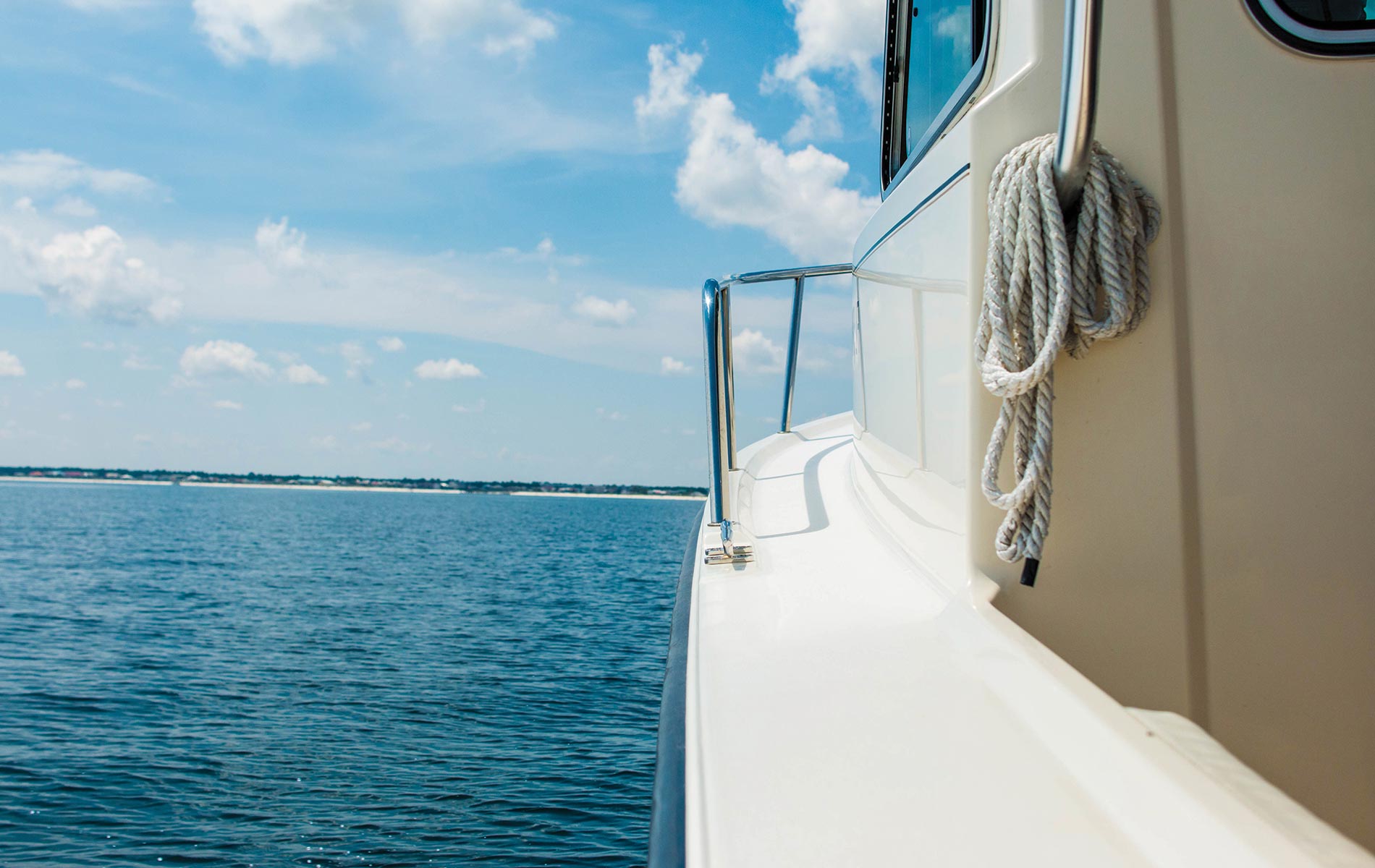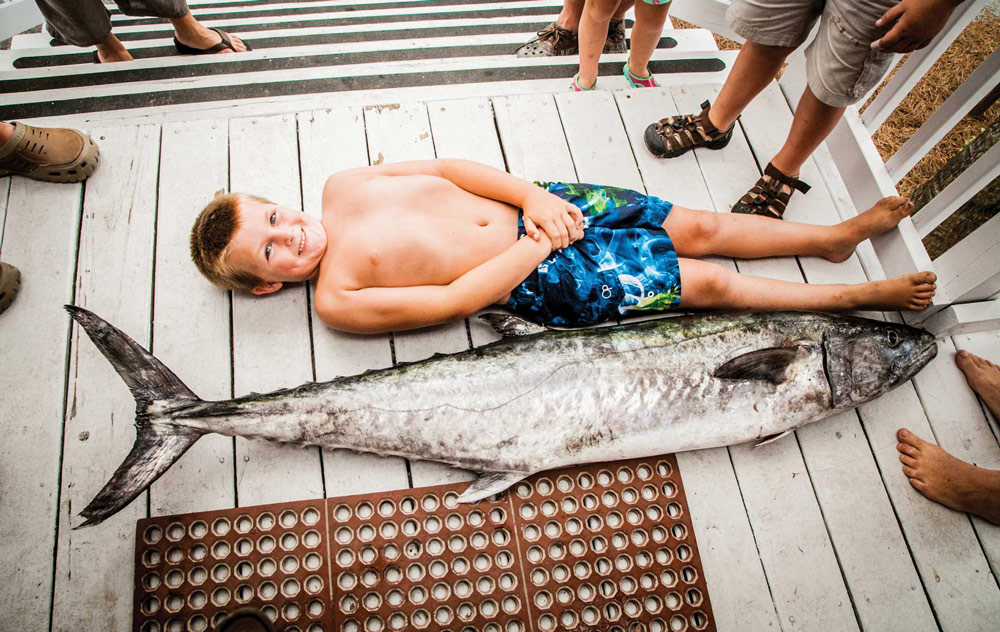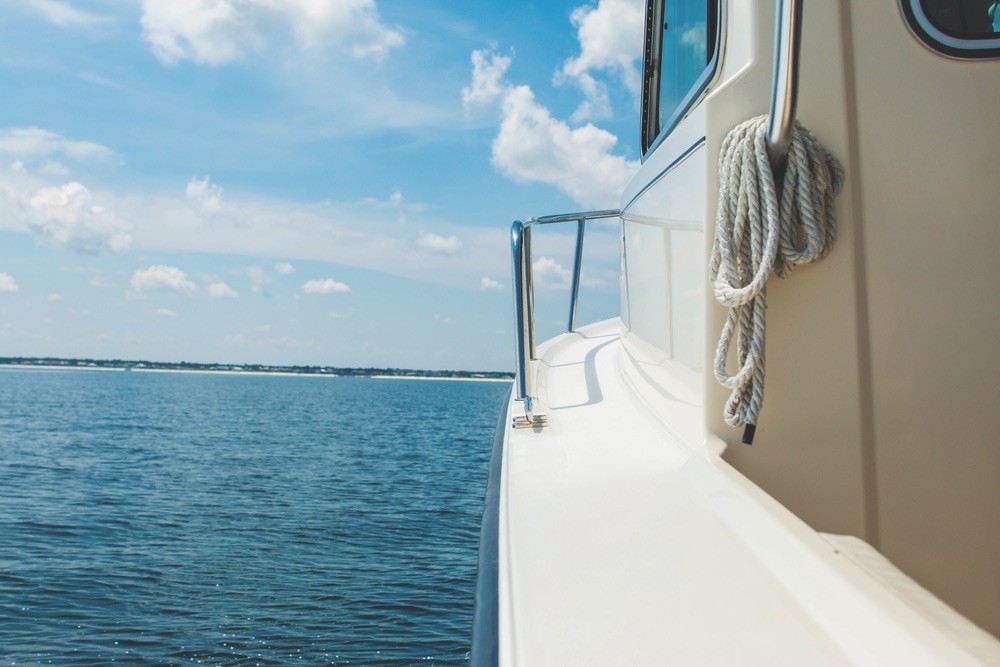
vie-magazine-mexico-beach-fishing-hero
The Great Bite
A Mostly True Tale of Phenomenal Sportfishing
By Chad Thurman | Photography courtesy of Mexico Beach Community Development Council
Call me Fishmael. Some years ago—it doesn’t matter when exactly; only know that it was another lifetime altogether—I, like many others before me, elected to clear my thoughts by trying my hand at fishing the waters off of the Northwest Florida coast. This particular afternoon in late August turned out to have beautiful weather and perfect conditions for this endeavor. Once upon the water, we were able to quickly and efficiently muster a fine mess of perfectly proportioned black snapper for our highly anticipated evening fish tacos.
As the sun began to slip beneath its watery blanket on the horizon, our thoughts turned to the return voyage and the bounty of succulent morsels of fish that awaited. It was time to call it a day. The bite of the fish had begun to slack off—that is, save for that last bite, the Great Bite, as it would later be known.
Suddenly and with thunderous fury, the quiet was shattered as my reel began to spool out, singing the melodies of a line tightened by a large fish. The tip of the pole in my hands doubled under as the reel’s drag was locked in a seemingly inseparable dance of splendid effort between the unseen force that lurked beneath the waves and its beckoning puppet master above. The fish was on.
[double_column_left]
It was then, many years ago, that I and those with me witnessed an exhilarating and exhausting battle that made it seem as if the very seafloor was being torn asunder. At long last, we beheld the glorious beast as it begrudgingly breached the surface. Having no means sufficient to net the magnificent mass, the crew attempted to hoist its hulking girth onto the vessel. Maneuvering the fiend from its watery womb to a position where it could crest safely over the starboard gunwale, we paused briefly to behold what was surely the largest black snapper that mankind had theretofore known. The men wept at the sight.
[/double_column_right]As we gazed in wonderment, the gossamer leader twinkled in the waning sunlight. At the exact moment that the size of the fish was properly fathomed, we all heard the tensile sound of fluorocarbon snapping: a high-pitched pop that deflated all our exuberance in an instant.
In veritable slow motion, we watched as the brute slid over the boat’s side and back into the foaming, churning abyss below. All was quiet for a moment. We had lost the Paragon of the Piscine, the Mother of All Black Snapper—the MoABS.

After much time had passed, my spirit and constitution healed and, strong from the vexing, I gained knowledge of reports of those who claimed to have spotted the MoABS (pronounced “Mobes”) nearby. Tales supported rumors purported by fishermen who had tracked the MoABS and its progeny over the past decade to the artificial reef emplacements of Mexico Beach, Florida.
[double_column_left]MBARA
Since its incorporation in 1997, the Mexico Beach Artificial Reef Association (MBARA) has had a three-part mission: to construct an artificial reef habitat to enhance sustainable fishing and wildlife growth off the coast of Mexico Beach, to educate the public on the values of sustainable artificial reef fisheries in the Gulf of Mexico, and to promote scientific research and evaluation of reef designs, biomass development, and fish productions. At present there are over two hundred reef emplacements deployed there, with more planned and happening every year.
[/double_column_left] [double_column_right]
MBARA has hosted marine ecosystem and artificial reef workshops for adults as well as for children in public schools, allowing many youngsters their first opportunity to get up close and personal with our marine ecosystems. Working closely with the City of Mexico Beach, the Florida Fish and Wildlife Conservation Commission, and the United States Army Corps of Engineers, MBARA is well on its way to achieving the milestone of a thousand artificial reef emplacements. With the help of MBARA stewards including Bob Cox and Ron Childs, Mexico Beach has established an enriching fishery program nurtured by an actively engaged community.
The annual MBARA Kingfish Tournament is one event keeping the focus on the artificial reef program. Its purpose is to raise funds to build and deploy artificial reefs. All proceeds from the tournament are used to continue the creation of a thriving marine habitat and to improve the Mexico Beach fishery for everyone to enjoy. The event usually brings between one and two hundred vessels from all over the Southeast vying for the top king mackerel, wahoo, and Spanish mackerel. The tournament celebrates twenty years in 2016, with the main event taking place Saturday, August 27. Learn more or register to compete at MBARA.org.

Captain Mitch Coleman of FloriDaze Adventures charter company says, “It’s a really big deal that the tournament is family oriented. There will be a beer wagon, but it doesn’t get out of hand. There’ll be a captains’ party with door prizes; it’s a fun community event with a definitive purpose and goal in mind—the sustained enhancement of this fishery management.” Captain Coleman is a retired air traffic controller who uses his immense knowledge from years of observing the weather to augment his fishing. He charters primarily out to nine nautical miles from shore. “I don’t need to go any farther; that’s as far out as I need to go,” he says. “My bread-and-butter business in the winter is catch-and-release red snapper fishing. I get the fish up behind the boat; you can literally toss with spinning tackle to the fish you want to catch. And then we release them unharmed. It’s a healthy release because these are always fun and big fish that don’t have to worry about dolphins eating them as they make their way back down.”
Working closely with the City of Mexico Beach, the Florida Fish and Wildlife Conservation Commission, and the United States Army Corps of Engineers, MBARA is well on its way to achieving the milestone of a thousand artificial reef emplacements.

Captain Darrell Key has been landing memorable fish for fifteen years as a master fly angler of tarpon, among other species. Captain Key has fished from the Florida Keys all along the Gulf Coast to Venice, Louisiana. “There are over two hundred reef sites currently on the bottom off of Mexico Beach. The reefs are not only bringing people here to fish, but they’re also bringing fish here to the people,” Key assures. “The goliath grouper is supposedly endangered; it’s not endangered here. There is one or two on nearly every site.” Other pelagic, or deepwater, species that the artificial reefs bring in include sailfish and flying fish, as well as many baitfish. “The fishermen who are out here believe that the reason we are seeing this type of activity not commonly caught in our waters is because of the proliferation of artificial reef habitat that has been deployed over the last eighteen years. It’s good for the pelagic species, it’s good for the fish that live here year-round, and it’s good for the people who depend on the fish for sustenance and livelihood. We did not see this type of activity ten years ago or even five years ago; this fish resurgence is a direct result of the artificial reef program.”

Last year, MBARA was approved for a $1.5 million grant to build an artificial barrier reef three miles out on a site known as Bell Shoals, a place where locals already catch many of their cobia. When this project is finished, not only will it further increase the value of the cobia fishing off Mexico Beach, but it will also be a spectacular place to go snorkeling. People will be able to take guided tours and float for miles to see the different structures and the fish that inhabit a reef system. The barrier reef installation will surely enhance both the artificial reef program and the community as a whole.

Day One – The Dawning
I awoke on the first day of the hunt to an electric-blue flash of lightning followed by a long peal of thunder. For weeks, I had been gathering information, which led me to an ancient mariner who spoke of the last known sighting of the MoABS. For the price of one pint of beer, the old salt professed to know of a certain fishing rodeo weighmaster who had spotted the MoABS in 2010 and who was purportedly aboard a vessel known as the Gloria when it happened.
Through missing teeth, a waxed smile, and a beard holding the luxuriously creamy froth of properly hopped pale ale, the mariner told the tale of the weighmaster and his captain attempting to race a tempest back to harbor. It is said that as the waters raged, the old weighmaster, perched high in his lookout, spotted dozens of sea turtles, which began to swim around the vessel. There, in their midst, was none other than the diabolical beast—the MoABS.
With wild eyes the old salt told me how the weighmaster grabbed his trusty hand line, and in one sure shot was able to sink a treble hook deep into the hide of the malignant being. The ravenous beast flailed, and with safe passage just in sight the weighmaster began to bring the fiend to the side of the accursed vessel. It was then that a mighty bolt of lightning was unleashed from the heavens to strike the ill-fated Gloria, disabling her bilge systems and causing her to take on water. Within minutes, according to the old salt, it was all over. The fifty-foot vessel was laid to rest as the MoABS swam away east with the weighmaster still holding the line. Witnesses claimed that the Coast Guard arrived just in time to cut him loose and save his life.
With the last gulp of his pint, the old salt imparted to me that it was only after this tragedy that coastal residents came to know of and believe that the MoABS indeed possessed the supernatural powers to call forth minions, summon lightning, and sink ships.

So, knowing this fish like the veins in my arm, one stormy morning I came to be in the south room of the Driftwood Inn in Mexico Beach, overlooking the Gulf with two men rumored to have recently seen the MoABS in their waters.
Captain Coleman had gotten word to me that the brute was in the vicinity and had assured me that he could find and finish the task of bringing the MoABS to justice—though he knew we would need a bigger boat. So he agreed to enlist in the expedition as first mate under the one man who could lead us to the lair of the mythical leviathan, Captain Key. We would head out on his vintage Mako, the Low Key.
Key is the sort of man who can smell the fish, find the fish, entice the fish, stare them down, and bring them back to port with all passengers accounted for. He had what it took—except that he didn’t have all of something: his right forefinger was missing above the first knuckle. Rumor had it Key lost this part of his finger during his last encounter with the MoABS. Alas, I had not the courage to ask him about it, for fear of having to swim many miles back to shore. Nonetheless, these were the men for the job.
[double_column_left]
Though on the first day of the expedition we would do nothing more than partake of coffee, watch the rain and lightning, and absorb the thunder, we also made our plan. With the new moon, we charted a judicious two-day course to explore all areas of the Mexico Beach artificial reef system in search of the MoABS. We would have to wait for the weather to clear, but before we left the Driftwood Inn that soggy day, Captain Key foretold that we may ultimately have to “bring in he who communes with the fishes.” With that statement there was silence, and I wondered what would be.
[/double_column_right]Day Two – The Parting of the Clouds
The fierce weather of the morning cleared and we elected to launch the Low Key for an afternoon reconnaissance voyage. We made our way out through the pass to open waters, assessing the bite by fishing for king mackerel—purportedly the choice morsel of the MoABS. Within ten minutes of exiting the pass and three minutes of wetting the hook, we had caught our first kingfish. Not only did this portend well for the rest of our hunt, but it also shone light on the impressive ferocity of striking kingfish in the artificial reef area just one month before the upcoming MBARA Kingfish Tournament.
After assessing our quarry, we changed tackle and began our efforts at locating the lair of the beast. Throughout the afternoon, we experienced nearly nonstop catch-and-release fishing off many of the artificial reef structures. Eventually we decided to move to an area where the MoABS had recently been spotted, an area known as the Tower. Lo and behold, before we were able to weigh anchor we spotted a lone turtle near the boat, steadily eyeing our toil. Just then, Captain Key called out that he had witnessed a phantom on the sonar fish finder; something big had passed below. It had gone as suddenly as it appeared, and we were left with stillness under the burgeoning moonlight. Was this turtle perhaps a minion of the MoABS? We continued to catch and release many fish into the early evening, though we did not find our prize.

The moon disappeared behind the shroud of an approaching fog, beckoning us toward shore and sleep, and Captain Key ordered Coleman to prepare the bow to point north. As Coleman readied the vessel, he let out a sigh as he uttered, “We’ll have to summon Beauregard the Fish Whisperer.”
Day Three – The Fathoms Below
On the third day we woke early with a good start of beautiful weather. We gathered at Captain Key’s garrisoned compound, where I met Beauregard the Fish Whisperer for the first time. As I walked up to shake his hand, he stood tall and straight with the rising morning sun behind his head. He appeared as an always-smiling man with a relaxed countenance, a florid complexion, and a determination to bring forth that which we sought.
Though the seas this day were sporty with five-foot swells, our spirits were high, and now we had the Fish Whisperer on board. We worked the Low Key out of port, pointed the bow to the southwest, and commenced out along over two hundred artificial reef emplacements, which the captains knew by name and number as well as by the types of fish most often found at each one. We spent the afternoon churning the waters, catching many fish, and enjoying the sun. We were on a path to an area of a MoABS sighting, known as the Car Bodies, so called because over many years, old railroad cars had been placed there as fish habitats. It is now a thriving part of the Mexico Beach artificial reef. We prepared our tackle and our mortal souls to challenge the MoABS once again.

After a short benediction, Captain Key ordered the bait into the water as Beauregard, barely audible at first, began to chant. His meter reached a rhythmic pulse and his tone a consonant pitch; multitudes of ravenous red snapper appeared, all rolling on the surface in a metered dance with the Fish Whisperer; it was truly a sight to behold. Within minutes of beginning his ritual, Beauregard had summoned the biggest and most beautiful red snappers to the back of the boat, fish of a size rarely found within sight of shore. If a net had been at hand, no doubt we could have scooped a few out of the fold. Captain Key ordered the fishing to begin, and with medium spinning tackle we caught red snapper after red snapper after red snapper, but we still had yet to face our ultimate prize.
With sunset imminent, Captain Key ordered that we return to shore before an approaching storm made its way in. Just then, in the subsiding melee that had been summoned by Beauregard, I spotted an ominous, gigantic shadow looming beneath the boat. All of the fish that had been gathered around the Low Key disappeared to the depths as the leviathan swirled and twirled the waters with its massive tail. For several grueling and anxious minutes, we tried to hook the creature to ascertain whether it was indeed the MoABS. Ultimately, we were unsuccessful. We had to move on before the approaching storm sent us to join that which lurked below.
Though we did return to port safely with all men on board, I still feel crestfallen. In my heart of hearts, I know that the MoABS is still out there, mercilessly swimming the depths of the Mexico Beach artificial reefs until the day that fate dictates I may return. The brute and I will meet again on Poseidon’s battlefield. Next time, though, I think I’ll bring along a nuclear-powered submarine, about three dozen hired harpooners, a diving bell, and perhaps some dynamite.
— V —
To learn more about the phenomenal year-round sportfishing, beaches, events, and more in Mexico Beach, Florida, visit www.MexicoBeach.com.
Share This Story!
KEEP UP WITH THE LATEST STORIES FROM VIE

































































































































